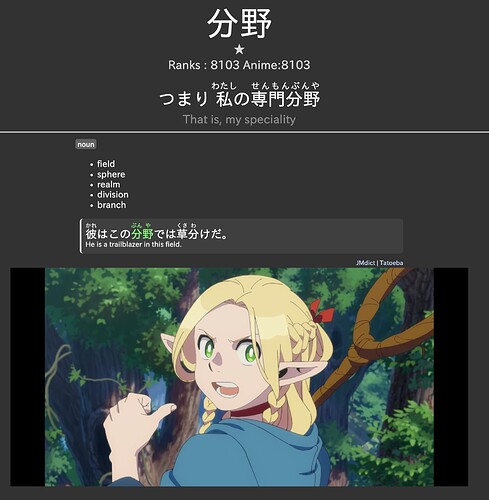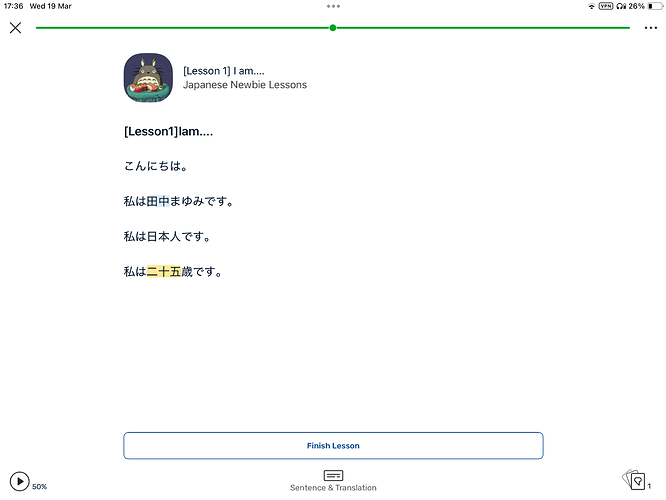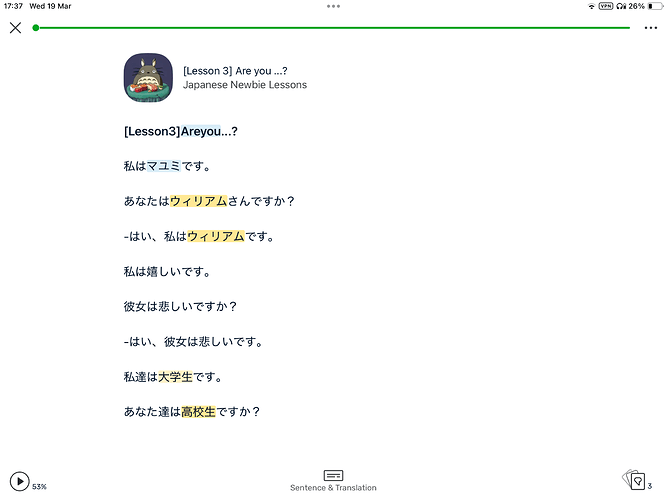im using bunpro for vocab, do you think its better to use the core2k deck or just use the bunpro n5 and n4 decks? my goal is being able to do immersion as quickly as possible.
In that case, I’d do the core2k!
If you want to take the JLPT too, maybe do the N5/N4 decks next?
The good news is that there is lots of crossover between those decks, so you can often kill 2 birds with 1 stone!
PS
Birds, not rabbits plz 
Personally I use both. I found that doing the bunpro decks gives me better context of how to use the words in sentences, especially with the variety of definitions and contexts, but I also found that I wasn’t really recognizing the kanji that make up the word. So I set any vocab I learn from bunpro’s decks to “due” in the core 2k/6k/10k. The other advantage of both is that I’m getting an extra review to help keep the material memorized. It probably seems like that takes up too much time, but it honestly takes no time at all if you’ve got the material locked in from the extra reviews. It works for me anyway.
Kaishi 1.5k
If your only goal is immersion, a Core2k deck might be better. There is one in the community decks you can try. The N5/N4 decks got a bunch of vocab about travel (like all types of tickets, all types of trains,…) and medical stuff (IV, eye doctor, OB/Gyn) which will probably unneccessary for you. But bunpro in general comes with sentences and “read and grade” function, which I think is great for immersion. So I would suggest looking at the Community decks on here 
If immersion means listening to content (not reading), then the fastest way there might be a deck focused on listening.
Front: audio+word in kanji+furigana, Back: meaning. Self-grade if you know the word
Or Front: audio+sentence in kanji+furigana, Back: meaning. Self-grade if you know every word.
I don’t think either Core2k or Kaishi by default are set up that way(?), but in Anki it’s pretty easy to reconfigure cards.
AKAIK Bunpro can only play audio after revealing the answer even if you set it up for reading with self-grade.
But if immersion means reading, then please disregard this comment 
Edit: when I was starting Japanese, I didn’t think of this approach, and haven’t used any of vocabulary decks. I did make my own sentence listening deck by cutting up some anime episodes though. I still remember many of those sentences verbatim for better or worse.
You can manually play the audio, by either clicking or pressing “P” twice, which is a work-around, but yeah.
I’m a little biased since I did core 2k and 6k. In presentations and shared materials it is always something I recommend.
It was instrumental in building the foundation to my vocabulary. You can then supplement with Bunpro which has a bevy of really good words and phrases.
I liked both the 2k and 6k separate decks. Would recommend either.
My preference is a deck that has:
- example sentences
- written in kanji
- audio
- i+1
this means each sentence only includes 1 new word.
I used Jalup (now Nihongo Lessons) Bunpro really isn’t, and there are core decks that are. I recommend getting an i+1 deck like this one:
https://ankiweb.net/shared/info/911122782
Then you can read all the example sentences
If you like the i+1 style, then spend the 300 dollars for 8,000 words with i+1 Japanese definitions and native audio at Nihongo Lessons.
IMO the best deck is the one you mine yourself. Why ? Well, frequency is domain specific, so when you follow a frequency list, you might not see words that are extremely used in the domain of your specific anime.
For example, if you watch fantasy shows, you might have to wait for 10-30k to meet certain words. For an anime like bleach, 魂魄、死神、霊圧 are Rank 142k, 20k and 4k/35k (based on BCCWJ). But those two words might be Top 100 in that specific anime.
So if you’re still too new to japanese to feel at ease mining, my advice would be : Take a deck with not that many words, and try to find one with somewhat the frequency of what interest you. Core2K is based on newspaper if I’m not mistaken, so it might not be ideal for you.
Also, verbs, conjunctions, will have a lot of frequency compared to concrete noun, and noun will have the same level, which bury them very low.
In addition to vocab you need either some kanji study for reading or listening for anime. I started off with genki 聞く練習 and 初めてお使いfor listening practice.
Mining is a good tool once you start immersion. Not satisfying pre-immersion.
I am level 60, nolonger new to Japanese. I am trying my best - but mining is really hard for me. I have spent 8 hours over two weekends mining the 45 words I didn’t know in episode 1 of 鋼の錬金術師 Full Metal Alchemist (about a word every other sentence).
Really enjoyed my premade deck. Only got 135 cards left in it tho. This is one of the cards I made last weekend.
Expression: 大いなることを 成すには 犠牲はつきものだ
Meaning:何かを得るために与えられたり、なされたり、行われる物によって測る価値
- コスト
Reading:
Audio: mp3
Expression, Reading and Audio are from Language Reactor. Meaning is from https://thesaurus.weblio.jp/
If I didn’t already read a bunch of Japanese defintions for words in Jalup don’t think I could do this.
Problem is, even if you finish a Core 5K deck, most of the words you’ll meet in Full Metal Alchemist might still be unknown.
Mining “suck” but at the same time you can also target content with less various vocabulary. Novels, or Anime about metaphysical concepts will of course have a way way larger vocabulary, that even Core Decks won’t be able to cover.
CoreDecks will only cover the Core, which can be already quite enough for things like easy vlogs, but for more “deep” content you’ll always get the same struggle.
To give you some idea, I’m mining around ~4 cards/min for a show like Violet Evergarden, something like ~16 for “Dungeon Meshi”. Simply because Dungeon Meshi is more packed with dialogues and cooking related words. Words that would not even show up in any Core Decks.
So yeah, going too much in one extreme in terms of difficulty can be very difficult, so finding good balanced content is a good way to start mining !
Edit: sorry got a bit mad. One word every two sentences is closer to 10% of the words than most of the words >50%
While I agree mining is a good stratagy at our level- you are level 75. I worry you are miss remembering how useful N4 and N5 vocabulary is. And how daunting “most of the words you meet might still be unknown” is
I think OP knows about 1,000 words so this sentence looks like
○○なる○○を○○には*○○は○○だ using frequency data from kanshudo. (*Don’t know には yet, but N5 covers にand は seperately) 5/10, exactly half
And the dictionary definiton would be
何かを○○○○○○○○、○○、行○○物に○○○○(N5) 3/15
Compared to N4
○○なることを 成すには ○○○○だ 7/10
何かを得る○○与えられたり、なされたり、行○○物に○○測る価値 10/15
I personally was demoralized by hearing ‘the best anki deck is the one you make your self’. I know that I should, I’ve heard this advice by many people, but I’d rather just have my anki reviews and my anime seperate.
I find it hard at my level 60, and I deffinitily couldn’t do it at all if I didn’t already know 5,000 words. I watched Dungeon Meshi without looking anything up.
If I’m practicing Japanese by watching anime, and I pause it to look up a word in the subtitle- that ruins it for me. Even worse when I’m reading a paper book . Once I put my book down and pick up my phone- Phone out = game over. “If I’m gonna put on an anime (fun), just to read a dictionary (boring) instead what’s even the point?!”
And it’s even worse when I couldn’t use a Japanese dictionary because then I felt like “I’m spending more time reading English than Japanese, is it even Japanese practice?!”
That should go into the compendium of bad advice :^)
Not everyone is creative and is able to make good anki lists. Anyway, relying on lists to get you through a specific subject sounds like a recipe for disaster. as you pointed out, the general list will leave out a ton of subject specific words. I actually have both the dungeon meshi manga and full metal alchemist manga right next to me. I’d say I can understand almost all of FMA (opening to page 14-15 of the FMA) and on page 54-55 of the dungeon meshi it’s closer to 80%, though i just opened to random pages.
I’m giving a pass for 錬金術師 because the context makes it obvious. but words like 鋼 may slip past you if you’re not familiar with metals.
in meshi, 栽培 and 懐 made me lost in translation. But they say these words are also in both the top 3k and top 12k and in the jlptn1, so who knows?
Though to be fair, I read a lot of isekai not cookbooks, so that may explain why I’m able to better understand the fma over dungeon meshi due to lack of exposure to cooking words.
And remember just cause you’ve studied the word on anki or whatever it may still slip by you when reading. that’s okay too.
Hmm I see. I think the advice about mining your own deck comes from most people like me that have a setup that allow them to one-click mine a word, giving me a card like this
With the anime audio, etc etc.
So in that case, the cost of mining is pretty minor, and I can easily mine ~100cards/h without too much issues.
Because to be fair, the example you give, I think most of those words are things you can find in a Top 1-2K deck. But once you go north to 2k, frequency becomes very very domain specific. For example, In Dungeon Meshi, a lot of entries are 20-30K because it will be a bit more related to fantasy/food.

So if I had religiously to go “one by one” until I encounter those, I would have to do A LOT of Anki before encountering them.
Then of course it depends on the anime you’re watching, but I’m not sure knowing a “Core 6K” vs a “Core 1K” will give you really a lot less gaps to fill. And even if it is, what about the rest ? You’ll spend 15min making card by card for each gap ? I think getting used to have a one-click Anki import is a very small time investment compared to how much time it might save you.
Then of course, you can also just not Anki them at all and let natural exposure make you learn those, which is also totaly viable.
On that last point, I’d also insist on the fact that you don’t really have to watch every single anime with the same level of “associated burden” to call it like that. For example, right now I do ~1h every 1-2 days of Dungeon Meshi with that mining setup. But I also others animes without mining, and some even without JP subtitles !
It’s perfectly OK to mix and match different setups/commitment with different moods. I think a trap on Internet is to find things like AJATT (All Japanese All The Time) that make you believe you got to go hardcore or stop. You really don’t. Of course, the more commitment you put and the more time and the faster you could theoretically learn, but it’s also more risky to lead to burn out, which is worst.
So to give a quick recap of my thoughts, I still agree that a good Core 1-2K deck can be valuableto kickstart your vocabulary, but once you’re more at ease with sentence structure and the tooling, it can be extremely good to not rely too much on Anki and Core Decks made by others. I even think it might be better, if you really don’t want to mine, to maybe spend more them watching anime and doing look-ups than sacrificing that time doing SRS alone and waiting to grind 30-40K words like that. If you do 20 new card/day, 40K words represents 5.5 years of grinding, which is not really sustainable when maybe only 2-3% might be very important on a specific anime / thema
I wold have started mining from the day one if I was about to start again, there are some really simple resources like those lessons on lingq (just an example) :
Or something like this:
Maybe todoku books?
Op would probably prefere something more advance I feel.
Also, I like mining words from my ghosts, that way I’ll learn those words well for sure and they won’t become leaches
Setting up yomitan + asbplayer + anki is key thing here to mine cards easily: https://youtu.be/PAUYnp5wOE0?si=j-Sfoana-Cm2P_q7 (I didn’t watch this one, but it is probably a good totorail).
Migaku should do the same but with less afford to setup
What is your card mining setup?
Haven’t read the context here that you’re responding to.
Will say I use a similar setup, honestly its actually unavoidable if you want to understand things that you’re actually interested in.
Best to get into mining/own decks as early as possible.
For example I love medieval fantasy stuff, here’s some random ones I’ve encountered, can you read and understand what these mean?
居合 (Seen this in multiple different shows)
白刃
タルワール
I’ve done both 2K and 6K separately, am deep in wanikani. You just simply wont encounter these things using the popular premade decks



